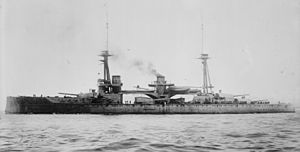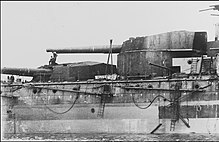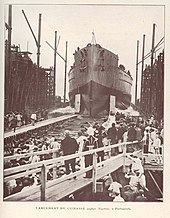HMS Neptune (1909)
 Neptune before 1914
| |
| Class overview | |
|---|---|
| Operators | |
| Preceded by | St Vincent class |
| Succeeded by | Colossus class |
| Completed | 1 |
| Scrapped | 1 |
| History | |
| Name | Neptune |
| Namesake | Neptune |
| Ordered | 14 December 1908 |
| Builder | HM Dockyard, Portsmouth |
| Laid down | 19 January 1909 |
| Launched | 30 September 1909 |
| Completed | January 1911 |
| Commissioned | 11 January 1911 |
| Out of service | November 1921 |
| Fate | Sold for scrap, September 1922 |
| General characteristics (as built) | |
| Type | Dreadnought battleship |
| Displacement | 19,680 long tons (20,000 t) (normal) |
| Length | 546 ft (166.4 m) (o/a) |
| Beam | 85 ft (25.9 m) |
| Draught | 28 ft 6 in (8.7 m) |
| Installed power |
|
| Propulsion | 4 × shafts; 2 × steam turbine sets |
| Speed | 21 knots (39 km/h; 24 mph) |
| Range | 6,330 nmi (11,720 km; 7,280 mi) at 10 knots (19 km/h; 12 mph) |
| Complement | 756–813 (1914) |
| Armament |
|
| Armour | |
HMS Neptune was a
The ship became part of the
Background and description
The
Neptune was an improved version of the preceding
Neptune had an
The ship was powered by two sets of
Armament

Neptune was equipped with ten 50-

Neptune was the first British dreadnought with her
Fire control
The control positions for the main armament were located in the
Neptune was the first British dreadnought to be built with a gunnery director, albeit an experimental
Additional nine-foot rangefinders, protected by armoured hoods, were added for each gun turret in late 1914.[16] Furthermore, the ship was fitted with Mark I Dreyer Fire-control Tables by early 1916 in each transmission station that combined the functions of the Dumaresq and the range clock.[17]
Armour
Neptune had a
The three armoured decks ranged in thickness from 1.25 to 3 inches (32 to 76 mm) with the greater thicknesses outside the central
Modifications
Construction and career

Neptune, named after
First World War
Between 17 and 20 July 1914 Neptune took part in a test mobilisation and fleet review as part of the British response to the July Crisis. Arriving in Portland on 27 July, she was ordered to proceed with the rest of the Home Fleet to Scapa Flow two days later[5] to safeguard the fleet from a possible German surprise attack.[23] In August 1914, following the outbreak of the First World War, the Home Fleet was reorganised as the Grand Fleet, and placed under the command of Admiral Jellicoe.[24] Most of it was briefly based (22 October to 3 November) at Lough Swilly, Ireland, while the defences at Scapa were strengthened. On the evening of 22 November 1914, the Grand Fleet conducted a fruitless sweep in the southern half of the North Sea; Neptune stood with the main body in support of Vice-Admiral David Beatty's 1st Battlecruiser Squadron. The fleet was back in port in Scapa Flow by 27 November[25] and the ship began a refit on 11 December.[22]

Neptune's refit had concluded by the evening of 23 January 1915 as she joined the rest of the Grand Fleet when it sailed in support of Beatty's battlecruisers,
The Grand Fleet conducted sweeps into the central North Sea on 17–19 May and 29–31 May without encountering any German vessels. During 11–14 June the fleet practised gunnery and battle exercises west of Shetland,[31] and trained off Shetland three days later. On 2–5 September, the fleet went on another cruise in the northern end of the North Sea, conducting gunnery drills, and spent the rest of the month performing numerous training exercises. The ship, together with the majority of the Grand Fleet, made another sweep into the North Sea from 13 to 15 October. Almost three weeks later, Neptune participated in another fleet training operation west of Orkney during 2–5 November.[32]
The fleet departed for a cruise in the North Sea on 26 February 1916; Jellicoe had intended to use the
Battle of Jutland

The German High Seas Fleet, composed of sixteen dreadnoughts, six pre-dreadnoughts and supporting ships, departed the Jade Bight early on the morning of 31 May in an attempt to lure out and destroy a portion of the Grand Fleet. The High Seas Fleet sailed in concert with Rear Admiral Franz von Hipper's five battlecruisers. The Royal Navy's Room 40 had intercepted and decrypted German radio traffic containing plans of the operation. In response the Admiralty ordered the Grand Fleet, totalling some 28 dreadnoughts and 9 battlecruisers, to sortie the night before to cut off and destroy the High Seas Fleet.[35]
On 31 May, Neptune, under the command of
Subsequent activity
After the battle, the ship was transferred to the
On 22 April 1918, the High Seas Fleet sailed north for the last time in an unsuccessful attempt to intercept a convoy to Norway, and had to turn back two days later after the battlecruiser SMS Moltke suffered engine damage. The Grand Fleet sortied from Rosyth on the 24th when the operation was discovered, but was unable to catch the Germans.[38] Neptune was present at Rosyth when the German fleet surrendered on 21 November and was reduced to reserve there on 1 February 1919 as she was thoroughly obsolete in comparison to the latest dreadnoughts. The ship was listed for disposal in March 1921 and was sold for scrap to Hughes Bolckow in September 1922. She was towed to Blyth, Northumberland on 22 September to begin demolition.[22]
Notes
- ^ In his 1919 book, Jellicoe generally named only specific ships when they were undertaking individual actions. Usually he referred to the Grand Fleet as a whole, or by squadrons and, unless otherwise specified, this article assumes that Neptune is participating in the activities of the Grand Fleet.
- ^ The times used in this section are in UT, which is one hour behind CET, which is often used in German works.
Citations
- ^ Marder, pp. 135–139
- ^ Brown, pp. 38–40; Burt, pp. 105, 107, 110; Friedman 2015, pp. 105–107, 109; Parkes, p. 510
- ^ Friedman (2015), p. 419
- ^ a b Preston (1972), p. 126
- ^ a b c d e f g Burt, p. 112
- ^ Burt, pp. 31, 64, 112–113
- ^ Friedman (2011), pp. 62–63
- ^ a b c Parkes, p. 509
- ^ Friedman (2011), pp. 97–99
- ^ a b Preston (1985), p. 25
- ^ Burt, p. 110
- ^ Friedman (2011), pp. 97–98
- ^ Brooks (1995), pp. 40–41
- ^ Brooks (2005), p. 48
- ^ Brooks (1996), p. 166
- ^ Admiralty Weekly Order No. 455 of 6 October 1914, referenced in footnote 32, "H.M.S. Neptune (1909)". The Dreadnought Project. Retrieved 4 February 2017.
- ^ Brooks (2005), pp. 157–158, 175
- ^ Burt, pp. 110, 112–113
- ^ Friedman (2015), p. 107
- ^ Burt, pp. 113–115
- ^ Silverstone, pp. 253–54
- ^ a b c d e f g Burt, p. 116
- ^ Massie, p. 19
- ^ Preston (1985), p. 32
- ^ Jellicoe, pp. 163–165
- ^ Monograph No. 12, p. 224
- ^ Jellicoe, pp. 194–196, 206–207
- ^ Burt, p. 38
- ^ Monograph No. 29, p. 186
- ^ Jellicoe, pp. 211–212
- ^ Jellicoe, pp. 217, 218–219, 221–222
- ^ Jellicoe, pp. 228, 243, 246, 250, 253
- ^ Jellicoe, pp. 271, 275, 279–280, 284, 286
- ^ Jellicoe, pp. 286–290
- ^ Tarrant, pp. 54–55, 57–58
- ^ Campbell, pp. 156, 202, 205, 207, 210, 212, 349, 358; Tarrant, p. 151
- ^ Halpern, pp. 330–332
- ^ Newbolt, pp. 235–238
Bibliography
- Brooks, John (2005). Dreadnought Gunnery and the Battle of Jutland: The Question of Fire Control. London: Routledge. ISBN 0-415-40788-5.
- Brooks, John (1995). "The Mast and Funnel Question: Fire-control Positions in British Dreadnoughts". In Roberts, John (ed.). Warship 1995. London: Conway Maritime Press. pp. 40–60. ISBN 0-85177-654-X.
- Brooks, John (1996). "Percy Scott and the Director". In McLean, David; Preston, Antony (eds.). Warship 1996. London: Conway Maritime Press. pp. 150–170. ISBN 0-85177-685-X.
- ISBN 1-55750-315-X.
- Burt, R. A. (1986). British Battleships of World War One. Annapolis, Maryland: Naval Institute Press. ISBN 978-0-87021-863-7.
- Campbell, N. J. M. (1986). Jutland: An Analysis of the Fighting. Annapolis, Maryland: Naval Institute Press. ISBN 0-87021-324-5.
- ISBN 978-1-84832-225-7.
- Friedman, Norman (2011). Naval Weapons of World War One: Guns, Torpedoes, Mines and ASW Weapons of All Nations; An Illustrated Directory. Barnsley, UK: Seaforth Publishing. ISBN 978-1-84832-100-7.
- ISBN 1-55750-352-4.
- OCLC 13614571.
- ISBN 978-1-59114-259-1.
- ISBN 0-679-45671-6.
- Monograph No. 12: The Action of Dogger Bank – 24th January 1915 (PDF). Naval Staff Monographs (Historical). Vol. III. The Naval Staff, Training and Staff Duties Division. 1921. pp. 209–226. OCLC 220734221.
- Monograph No. 29: Home Waters–Part IV.: From February to July 1915 (PDF). Naval Staff Monographs (Historical). Vol. XIII. The Naval Staff, Training and Staff Duties Division. 1925. p. 186. OCLC 220734221.
- ISBN 0-89839-255-1.
- ISBN 1-55750-075-4.
- ISBN 0-88365-300-1.
- Preston, Antony (1985). "Great Britain and Empire Forces". In Gray, Randal (ed.). Conway's All the World's Fighting Ships 1906–1921. Annapolis, Maryland: Naval Institute Press. pp. 1–104. ISBN 0-85177-245-5.
- Silverstone, Paul H. (1984). Directory of the World's Capital Ships. New York: Hippocrene Books. ISBN 0-88254-979-0.
- Tarrant, V. E. (1999) [1995]. Jutland: The German Perspective: A New View of the Great Battle, 31 May 1916. London: Brockhampton Press. ISBN 1-86019-917-8.
External links
- HMS Neptune on the Dreadnought Project Technical material on the weaponry and fire control for the ships
- Battle of Jutland Crew Lists Project – HMS Neptune Crew List
